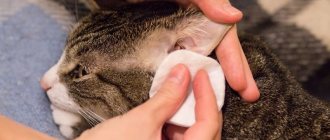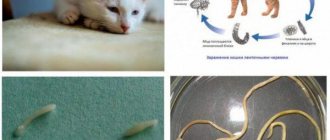If a cat scratches its ears and shakes its head, this does not always indicate that the pet is sick.
The disease may be accompanied by the following symptoms: refusal to eat, nervousness, meowing, the appearance of an unpleasant odor and discharge from the ears.
A simple explanation for itching is poor hygiene.
More serious causes are ear scabies, otitis media, dermatitis, mite damage, the formation of hematomas, tumors, and polyps. In order not to start the disease, you should take the cat to the veterinarian at the first manifestations.
Why does a cat scratch its ears?
If your pet begins to behave restlessly, constantly scratch itself and shake its head, the reason for this may be the animal’s predisposition to problems with hearing organs.
This category includes:
- Anomalies in shell structure.
- Anatomical structure of the organ associated with the characteristics of the pet’s breed.
- Congenital narrowing of the auditory canal.
Problems can arise from injury during brushing, or from excessive wax production. Blockage of the ear canal occurs if the cat has polyps, granulomas or other tumors in the ears.
The primary factors for ear diseases include:
- Presence of mites in the ears.
- Entry of a foreign object.
- Allergic manifestations.
- Failure in the functionality of keratinization processes.
- Hyper or hypoplasia of the sulfur and sebaceous glands.
- Autoimmune pathologies.
- Damage to shells.
Supporting secondary factors:
- Disturbances in the balance of ear microflora.
- Penetration of fungal infection.
- Inflammation of the meatus followed by otitis media and fibrosis.
- Poor hygiene and improper cleaning.
Hygiene problems
If the breeder does not clean the pet's ears, then dirt accumulates in the animal's shells. This acts as a favorable soil for the production of pathogenic microorganisms.
Severe scratching may indicate the appearance of wax plugs.
This happens due to malfunction of the glands and increased secretion.
Sometimes this is related to the cat's breed . But improper aggressive cleaning of the passage can also provoke an abundance of sulfur.
In this case, no special treatment is required; you can remove the plug yourself by softening it with saline solution. If it is deep and cannot be treated, then to prevent damage to the ears it is necessary to show your pet to a veterinarian.
Diseases that cause itching
Ear scratching can be dangerous. Cats scratch their ears due to dermatitis, seborrhea, and otitis media.
Otitis
Characterized by tissue inflammation affecting the middle and inner ear. The disease can be the result of a cold, allergies, foreign body penetration, mites, infections, fungus, excess sulfur in the passages, liver and pancreas diseases.
With secondary otitis, a bacterial environment occurs, which is accompanied by purulent discharge and an increase in the pet’s temperature.
Dermatitis
May be superficial, purulent or oozing. Its symptoms, from ordinary scratching to purulent non-healing wounds, will depend on this.
Dermatitis can occur independently or be a consequence of otitis media, parasitic infection, or allergies. Pathology must be treated after identifying the cause of the disease .
Seborrhea
It begins when the functioning of the sebaceous glands is disrupted. A large amount of dandruff appears on the animal's fur. Problems with the glands may be congenital.
With dry seborrhea, there are no symptoms other than itching and dandruff; the weeping form of the disease leads to the loss of tufts of hair and the appearance of inflamed areas.
Hormonal disorders, problems with the thyroid gland, scabies, allergies, and dermatitis can cause pathology.
Parasitic lesion
Outdoors, your pet can become infected with fleas or ticks. Fleas live exclusively on animals and feed on their blood. Since insects are carriers of many diseases, during a bite they can transmit an infection to the cat.
When infected, small kittens develop anemia and allergic reactions. The animal may stop eating and lose a lot of weight.
Fleas live in a cat's fur. You can fight them at home using appropriate means. After treatment, your pet needs to be dewormed 2 weeks later.
Otodecosis (ear mite infestation) can affect one or both ears.
Scabies, caused by a parasite, causes the animal to scratch the shells until blood appears.
The pet becomes restless and nervous, he sleeps poorly, and refuses to eat. A sticky secretion is released from the ear canal, gluing the pile, which gives the cat a sickly appearance.
The tick itself is difficult to detect, but you can see its waste products and dark brown crusts in the depths of the passages.
The disease is contagious, so at the first manifestations it is necessary to take your pet to the veterinarian.
Infectious causes
Inflammation of the ears can spread throughout the entire auditory system: the disease can affect the concha, ear canal, middle and inner ear.
Inflammation can begin after untreated scabies, with improper care of the cat, or an allergic reaction to household chemicals or food.
The clinical picture in this case will depend on the degree, cause and location of the disease. Infectious pathology is accompanied by fever, apathy, refusal to eat, poor coordination of movements, and irritability.
In addition to scratching, the cat will constantly tilt its head towards the affected ear. With timely treatment, the prognosis is favorable, otherwise the animal may become deaf, and if the infection enters the brain, it will die.
What else causes itching?
A cat may scratch its ears when a foreign object gets into the ear canal. You should not take it out yourself - this can damage the eardrum.
The cat experiences itching and discomfort when tumors appear in the ears (tumors, polyps, hematomas). You cannot treat them yourself .
In the case of a hematoma, surgery and pumping out of the contents are often required. If a tumor occurs, the doctor diagnoses the disease and makes prognoses, choosing treatment.
The sooner surgery is performed, the greater the chance of a favorable outcome and preservation of the patient’s hearing.
Problems with the ears can occur after water procedures if the breeder did not use a special cap and water got into the auricle. Fluid stagnation causes inflammation, which can subsequently develop into a severe form of otitis.
Problem for small kittens
A kitten's anxiety can be due to any of the reasons listed above, but most often the problem is associated with otodectosis. Ear scabies occurs when infested with mites.
These parasites cannot be seen with the naked eye, which complicates the diagnosis and treatment process. Mites produce in the ear canal and shell.
Due to the pain, the kitten may meow pitifully and shake its head. If there is purulent discharge, you should immediately take your pet to the veterinarian, otherwise meningitis and death are possible.
Alarming symptoms
Cat ears are the real Achilles heel of these animals, since the openness of a cat's ears is an excellent excuse for parasites, water and foreign bodies to get in there. To avoid complications, it is advisable to examine your pet’s ears weekly in order to recognize an impending disease in time.
To prescribe treatment, it is necessary to identify the causes of incessant itching.
Among the manifestations indicating ear damage, the most common are the following:
- the cat makes unnatural movements with its head, shaking it as if trying to shake something out;
- the ears take on a more saturated pink or even reddish tint;
- the pet's ears become wet from the inside, purulent discharge is possible;
- an unpleasant odor emanates from the cat’s ears, which was not characteristic of her previously;
- crusts and scars appear on the surface of the ears;
- the cat compulsively scratches its ears, despite the wounds that form.
Consequences of intensive scratching
Home treatment
You should not prescribe therapy on your own, as you can waste precious time and trigger the disease.
You can help your pet at home if you are aware of the problem of anxiety. If you have wax plugs, you need to clean your ears using saline solution and cotton swabs with limiters .
You need to instill the drug into each ear, 2 drops three times a day for a week. If the cork does not come out, you can remove it with a cotton swab.
Without knowing what to do, if the wax is deep, it is better to have the plug removed at a veterinary clinic.
Important. If a foreign object gets into your ear, you should not try to pull it out yourself: you can damage the ear canal or drive the object even deeper.
Also, do not use soap solution, alcohol or hydrogen peroxide - this can cause irritation or ulceration of the shell.
It is dangerous to warm up the ears, since if the cat has started a purulent process, this will provoke its intensification.
Treatment of the wound if the cat scratched his ears until they bled
Treatment is necessary not to eliminate the wound, but to eliminate the cause. To calm the animal a little, you can apply a cold herbal compress to the affected area. Oak bark, chamomile, and calendula are suitable for the decoction.
To disinfect the wound, you need to wipe it with a decoction or tincture of calendula that does not contain alcohol, then the affected area is treated with Levomekol ointment.
If a cat scratches its ears a lot, Suprastin and Diazolin help relieve itching.
Dermatitis and eczema cannot be wetted, so acetylsalicylic acid-based talkers are used to treat them.
Do-it-yourself ear cleaning
Dust and dirt constantly get into your ears, so hygienic cleaning of sinks must be carried out regularly. To do this, you need to have a special product purchased at a pet store, or use saline solution (0.9%).
In the absence of these drugs, ordinary warm boiled water and a cotton swab will do. Use a moistened swab to wipe only the visible part of the sink.
Do not try to penetrate deeply, as this may damage the ear..
If there is a large accumulation of sulfur, the cleaning composition is dropped into the ear and after 10 minutes the animal is allowed to shake out the excess secretion by shaking its head.
Then, using cotton wool, carefully remove the loose plug and any remaining substance.
The use of soap, peroxide or alcohol is controversial, as some veterinarians claim that after such manipulations ulcers may appear, or the volume of sulfur released increases.
Diagnostic methods
If your cat is constantly scratching its ears and is very worried about other unpleasant symptoms, then you should not delay a visit to the veterinarian. Even if your pet’s ear is externally clean, but itching sensations are observed, then to be safe, it is recommended to be examined by a specialist. First, a visual examination is carried out and an additional clinical picture is clarified. If in this way it was not possible to find out why the cat’s ear itches, then a comprehensive diagnosis will be required. If otodectosis is suspected, scraping is performed with further microscopic examination. Using this diagnostic method, it is possible to identify the causative agent of ear scabies. The following manipulations are also performed to make a diagnosis:
The animal's hearing organs should be examined by a specialist during otoscopy.
- otoscopy with examination of the ear canal;
- blood and urine tests;
- laboratory test for sensitivity to antibacterial drugs.
Pet treatment
If you have a parasitic infection, you can treat your pet at home. Fleas are poisoned with special drops, anti-flea shampoos and insecticides for treating the premises. For prevention, the pet is wearing a collar that repels insects.
When treating otodectosis, ear drops Amitrazine and Frontline Spot On are used, and Stronghold is applied to the withers.
Before using the drops, clean the sinks with lotion Otoklin, Rosinka, Fitolar. In case of severe infection, use Benzyl benzoate or hyposulfite. If pus is released, therapy is expanded with antibiotics.
Otitis is treated with Aurican, Surolan, Bars, Oridermil.
For tick-borne inflammation, Tsipam, Decor, Anandin are prescribed. If the cause is a fungus, then it is advisable to use Aurizon, Clotrimazole.
A kitten with yeast and fungal otitis needs to restore its immunity, otherwise the problem will return again.
Bacterial otitis is treated with Otibiovin, Mastiet, Otonazole. In case of advanced pathology, blockades with Novocaine are necessary.
If scratching is caused by aggressive brushing, then light healing ointments can be used. It is not recommended to touch the shells at this time. The plugs are removed in the hospital or softened with saline solution.
For weeping dermatitis, the itching is relieved by instilling Novocaine, and the ulcers are dried with silver nitrate 2%.
The fungal infection is treated locally with the drug Chlorhexidine 0.05%, Ketoconazole tablets are given orally, and Otibiovin drops are injected into the sink.
If you have an allergy, it is important to understand the cause of the disease. Antihistamines taken by people help eliminate the problem.
Seborrhea is difficult to get rid of . The doctor prescribes what to treat; generally, bathing the pet using special shampoos (Fiprex, Doctor) is indicated.
If the problem is related to fungi, then Miconazole-based products are needed.
After bathing, you need to comb your pet. For dry seborrhea, to soften the skin, you should choose medications with vitamin A. This will help reduce flaking and itching.
Surgery
With early diagnosis of the problem and timely consultation with a doctor, the cat can be saved with conservative treatment.
Surgical treatment is necessary if a tumor is present . Sometimes this is required if a foreign object has penetrated too deeply.
A small incision is made to drain the hematoma. If there is an abscess, the wound is cleaned and drainage is installed to drain the pus.
Some forms of chronic otitis media cannot be cured with medications, so surgery is performed to narrow the ear canal.
How to treat if a cat scratches his ear until it bleeds
If the cat scratches the ear until it bleeds, then the wound is treated with hydrogen peroxide and sprinkled with crushed Streptocide tablets or lubricated with Panthenol, Trauma-gel or Ranosan ointment. It is not recommended to use iodine, brilliant green and Vishnevsky liniment on the auricle. These products have a strong cauterizing effect and can cause burns.
Prevention measures
To prevent your pet from having ear problems, you need to properly care for the animal.
That means:
- Periodically inspect and clean sinks with a cotton swab.
- Control during bathing (you need to make sure that liquid does not get into the ear canal).
- Isolation of domestic animals from street animals.
- Ensuring proper nutrition for your pet. It should be balanced and varied. Vitamin supplements should be given periodically.
- Timely vaccination, deworming.
- Compliance with scheduled preventive examinations.
Is it possible to prevent itching in an animal?
Preventive measures to reduce the risk of itchy ears in cats include:
- regular examination of the ears;
- purification from sulfur;
- treatment against parasites (domestic cats also need it);
- vaccinations on schedule;
- preventing water from getting into the ears when swimming, drying with cotton pads in case of numbness;
- avoiding hypothermia;
- strengthening the immune system with vitamins and nutritious food;
- Contact your veterinarian early if unusual symptoms appear.
To prevent diseases, you should not use antibacterial drugs or start treatment with them without examination. This leads to allergic reactions, development of drug resistance and the development of fungal skin diseases.
Itching of a cat's ears can be associated with wax plugs or water ingress, but if it is severe and prolonged with scratching of the skin, it is necessary to exclude infection, allergies, trauma, or foreign body ingress. Treatment is most often medicinal - ear drops, ointments. For prevention, you need to inspect and clean the ear canal.
Ear mite
Why does the cat shake his head and scratch his ears? It is possible that the animal has otodecosis. What kind of disease is this? Otherwise, the disease is also called scabies, or ear mites. This disease mainly affects weakened individuals, as well as those living in large groups. Typically, the mite parasitizes in the external passage or on the inside of the ear.
What are the main signs of this disease? In addition to itching in the ears, in the shells themselves, you can replace brown plaque, as well as sticky liquid. The consequences of such a disease are serious, including membrane rupture, meningitis, and others. If there is a problem with one ear, then both should still be treated.
Information for dog owners.
Otodectosis in dogs is extremely rare. Treatment of otodectosis in dogs is no different from that described for cats, using drugs as “Bars Forte ear drops for dogs” and “Aurizon” ear drops for dogs. We discussed the first drops in detail earlier. instructions, as well as the price of Aurizon ear drops, on specialized websites. With timely detection and treatment of otodectosis, the prognosis is favorable.
And in order for your pet to always be healthy and not suffer from ear diseases, do not forget about the basic preventive measures:
- ear hygiene,
- regular treatment of your pet with antiparasitic drugs,
- balanced nutrition and preventive examination.
How to identify pathology
Understanding that your pet needs your help is quite simple. First of all, as mentioned above, pay attention to how often the cat scratches its ears and shakes its head. For example, if a pet repeats the procedure several times per hour, then this is a clear sign of discomfort he is experiencing.
It is worth paying attention to the pet’s behavior. If you have ear diseases, your cat may become more aggressive and nervous. In some cases, on the contrary, the pet becomes lethargic and apathetic. Loss of appetite and refusal to play are equally alarming signs. Pay attention to how the cat reacts to your touching his ears.
Be sure to inspect your pet's ears. If they have diseases, cats can scratch their outer parts, as well as the area behind the ears, until they bleed. Dirt appears inside the ear canal, and the skin begins to peel off. In advanced stages of the disease, an unpleasant odor and discharge appear.
I myself have encountered ear problems with a cat only once. He scratched himself a lot and shook his head, and there was a smell of pus coming from his ear. Upon examination, it turned out that the problem was a deep scratch that the pet received during another skirmish with a “competitor.” To initially treat such damage, I use hydrogen peroxide, and then treat the affected area with zinc ointment. It quickly dries the damaged area, allowing the wound to heal faster.
If there are ear diseases, the cat becomes more aggressive, he may even bite and scratch the owner if he touches the affected area











